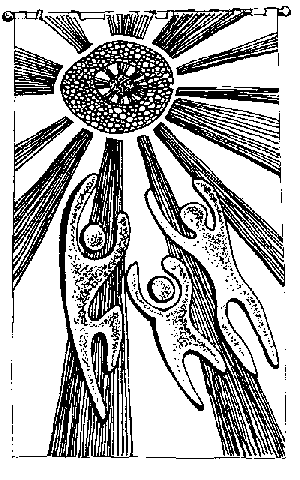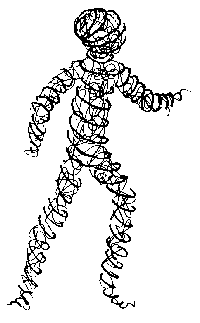This article is from Issue 67 of “On The Move,” a publication of new learning possibilities for churches, at one time published by The Joint Board of Christian Education of Australia and New Zealand.
Although some ideas and liturgies may appear somewhat “dated” in style, concept, imagery or language, they may nevertheless offer a spring-board for new ideas among people who find themselves leading worship, perhaps in a new context, and with some trepidation.
Reproduced with permission. May be reprinted for use in local congregations only.
SYMBOLS FOR PENTECOST
by Margaret Ray and Beth Knol

The dove-
tongues of fire-
a mighty rushing wind!
This article sets out some suggestions for making symbols to be used on Whitsunday, either two-dimensional, three-dimensional or multi-media. Each can be adapted to suit your available resources and the place where you will be celebrating this festival.In these suggestions there is a deliberate attempt to link the Holy Spirit with people. “God with us” is the message, whether it be Christmas, Easter or Pentecost. It is so easy to see the activity of the Holy Spirit as “out there” or “over there” instead of “here”, in us and through us. Effective symbols of Pentecost should remind us that Pentecost is not just an historical occasion of great significance to the church, but the continuing source of the church’s life. And the church is us.
The traditional symbols
The dove imposed on the flames (figure 1) is used in various ways. At the Avenue Church (Blackburn, Victoria) we adapted this for a banner made of green hessian with red flame (sailcloth) and white dove (crushed velvet). The diagram here shows heads of people. These could be painted on white or beige material with thick black brush strokes, or printed names may be preferred. These, in a small group, could be the actual names of the people making the banner and of people in the group for whom it is being made. Or they could be representative names—MARY, JOHN, CHARLOTTE, MICHAEL, ANNE etc—printed at random in a triangular shape at the right-hand corner.
Renewal, enthusiasm
Most would agree that Pentecost is about renewal, energy and enthusiasm. This theme can be depicted effectively in two-dimensional form—say a banner approximately 1.2 metres wide and 1.75 to 2.5 metres long, but adapted to circumstances and location (see figure 2).
 The idea of enthusiasm and renewal is symbolised in the leaping, jumping figures. The stylised figures could be cut out of corduroy and plain velvet to provide a texture contrast with the dominant symbol of the central sun.
The idea of enthusiasm and renewal is symbolised in the leaping, jumping figures. The stylised figures could be cut out of corduroy and plain velvet to provide a texture contrast with the dominant symbol of the central sun.
The central sun image (source of energy and/or guidance) is a variation on the traditional Pentecost flame. The central circle could be yellow, with the next row of rays (irregular in width) orange, then a row of red, and finally long orange rays.
The sun and rays need to be made of shiny material. Shiny (but not transparent) gift wrapping could be used, glued firmly to the coloured hessian background.
Machine-hem the banner, with side seams of approximately 2 cm, and hems two or three times that size at top and bottom, leaving the ends open to take a dowelling rod. Rods at both top and bottom help the banner to hang properly when completed.
The background and figures need to be in bright colours which will contrast well with the sun and rays. We used a banner similar to this for a Palm Sunday focus of worship, with large palm fronds behind the figures instead of the long rays. In this banner the background hessian was lime green, the figures were purple, and the light symbol was modified so that there was a cross shape suggested in yellow, orange and red.
Groups willing to involve more people and to plan ahead could use a variety of media centring on a power theme. Slides are one possibility, depicting power in nature, storm, lightning, wind, waterfalls or other large volumes of moving water. Music with strong trumpet and percussion can also suggest power. You might like to select from Beethoven’s 5th symphony or Dvorak’s 9th (“New World”) or the Poulenc “Gloria”—or whatever strikes you as appropriate. Another possibility is to use movement with, for example, a group of”movers” (dancers if you have them) in black jumpers and tights for the sake of uniformity, using arms, bodies, heads to bend as if blown by strong wind. If they are dancers they could choreograph a more ambitious sequence to your music so as to depict strength and power.
If these suggestions were used in the opening part of your worship the idea of power could then be taken in any of several directions: God’s power in our lives, power to love, power to change, power to heal etc.
Unity
An important aspect of the experience of the disciples at Pentecostwas the sense of unity in spite of difference: all speaking different languages but all hearing and understanding the word of God and experiencing God’s power.
A “massed sculpture” with three-dimensional figures could be used to depict unity. Plan on three or more figures about 50cm high (but not necessarily of uniform size). You will need to decide how to group the figures in a way which appropriately depicts the unity of the church. The idea of unity needs to be balanced with other aspects of the church’s life. For example, a grouping which was entirely inward looking would probably be rejected on the grounds that it appeared to turn away from the world.
 Very effective figures can be made of crumpled newspaper shaped and bound loosely with light, pliable wire. Over this newspaper skeleton wrap strips of rag (3 to 5cm wide) which has been dipped in plaster of Paris. Leave the figures to set. Later they can be painted. Silver with highlights in black, or copper with brown highlights, gives a metallic, sculptured effect. Simpler figures can be made from pliable wire twisted around a simple frame with teased out steel wool tucked into it to give a more solid effect (figure 3).
Very effective figures can be made of crumpled newspaper shaped and bound loosely with light, pliable wire. Over this newspaper skeleton wrap strips of rag (3 to 5cm wide) which has been dipped in plaster of Paris. Leave the figures to set. Later they can be painted. Silver with highlights in black, or copper with brown highlights, gives a metallic, sculptured effect. Simpler figures can be made from pliable wire twisted around a simple frame with teased out steel wool tucked into it to give a more solid effect (figure 3).
To give the massed sculpture a Pentecost touch you need just a simple backdrop. This could comprise strips of yellow, orange and red cellophane in irregular, waved shapes to suggest flames. Hang these from a horizontal wire, again adapted to your particular setting.
